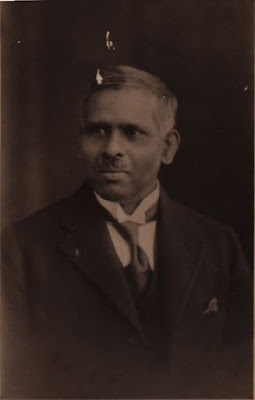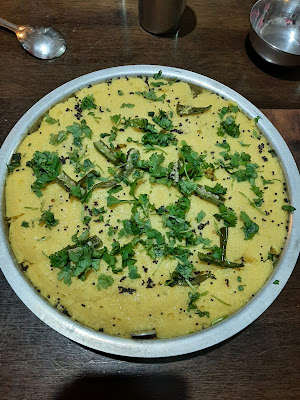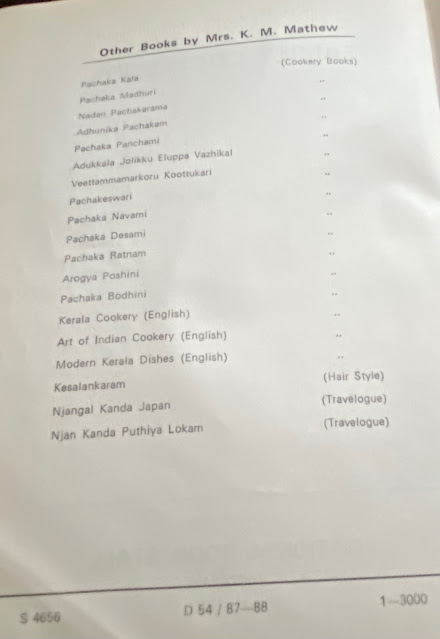While going through my ancient files, I came across this little blue notebook with my pet name on the cover.
SUSHIL is my Indian name, a tradition started by my paternal grandfather.
In the past, we were given our official name, in which the first was the House name that you belonged to from your father’s side. Then you added your father’s name and finally your own name.
The own name would then be made Malayali and would be used by your family and family friends. Occasionally, you also got called by a “pet” name which could be associated with your standing in society, your contribuion to society or just endearment.
My eldest maternal uncle was the late Padma Bhushan K. M. Cherian (Chetpet Appachen), . He got the name Cherian as being my grandfather's eldest son, he was given his great grandfather's name - Cherian.
Padma Bhushan is the award he was given by the Indian Government for his contribution to Indian journalism and work for Indian Independence. K stood for his family House name, Kandathil. M stood for his father's name. which was Mammen Mappillai.
Take a look at the names of all my mother's brothers in order of birth.
1. Padma Bhushan K. M. Cherian
2. K.M. Oommen
3. K.M. Eapen
4. K. M. Varghese Mappillai
5. K. M. Jacob
6. Padma Shri K. M. Philip
7. Padma Bhushan K. M. Mathew
8. Padma Shri K. M. Mammen Mappillai
The ninth member of the family was my mother, whose name should have been
Padma Acca K. M. Mariam (Padma Acca being my personal title for her) as she held 7 fiery brothers together to help them build MRF Ltd. , Malayala Manorama, MM Rubber Co. Ltd. amongst a host of other companies.
(Her brother, K. M. Jacob, died early and my name is Jacob as I was born shortly after he died. )
Without her strong hand and mutual love and affection with her brothers, this family would have broken up into fragmernts a long time ago. (This story will appear in my memoirs in due course.)
So you will note that each of them has the K. M. prefix before their own name.
My paternal grandfather took another route.
His name was Raja Mantra Pravina Dewan Bahadur Maliyakal Kuriyan (Mysore) Matthan.
Raja Mantra Pravina Dewan Bahadur was the title conferred on him by the Maharaja of Mysore for his services to the State of Mysore. The House name is Maliyakal, which is also my house name. His name from his father was Kuriyan (which be also spelt as Kurian). The pet name "Mysore" was given to him by the people of Mysore for his contribution to the state. His personal name was Matthan, but he turned it to his surname name. This was because he saw it as part of the western society he had become involved with and he changed from being a Syrian Christian to a member of the Protestant Church.
So his male children were
1. M. George Matthan (Commissioner Mysore Government)
2. M. Kuriyan Matthan (CEO Tata Engineering Consultancy Services, after being the Chief Engineer of the B. E. S. T. in Bombay)
3. M. Matthan Matthan (DCM)
4. M. John Matthan (CEO BHEL & CEO Integral Coach Factory)
5. M. Jacob Matthan (LIC Chairman)
My mother's family were all professionals and business oriented, while my father and his brothers were all professionals, all of whom reached the pinnacles in their professional life.
Coming to my name, it should have been Maliyakal Matthan Jacob, but as my paternal grandfather turned around the system, I got the name Maliyakal Jacob Matthan, but an Indian name was also added, which is SUSHIL. (My elder sister was Nalini, my elder brother is Ranjit, and my younger sister was Thangamma.). Sushil is used by my other family members and family friends who have known me since childhood.
But this is a digression, as the reason for this blog is that I found a small notebook a couple of days ago which had an article written by me in 1975 about the potential for trade between Finland and India.
Written by me 48 years ago, when I was just 32 years old, there may not be much technology significance today.
What interested me is not the content of the article but that I was able to write an article before my access to a computer in beautiful long hand, something which vanished when I returned to Finland in 1984, 9 years later, as my handwriting skills vanished. With the advent of the computer, and arthritis hitting me quite hard simultaneously, I resorted to using the compuiter for my writing to avoid the pain.
When I joined the University of Oulu, I was given access to IBM XT and AT computers, along with the IBM Mainframe.
My earlier computer access was when I was working in MRF. IBM opened their computer centre in Madras. All we had was preparing punched cards relating to the stocks in store.
I did not stay with the IBM Computers for long as I spent most of my time trying to remember key strokes and functions and less time creating my documents.
One day, a young lady arrived at the door of my University room from a company called Systema Oy. She convinced me to look at what she was selling. It was an Apple IIC computer which had a "mouse" and the commands were simple to remember.
I took to it immediately and my productivity went up 2000% compared to that of my colleagues.
Soon I had others working on my Apple IIC all day creating all sorts of scientific experimental stuff.
I had to wait till they went home to get my work done, which became quite simple as it was productivity oriented. What took them 4 hours on their computers, my productivity with my Apple Macs took hardly 2 hours! (This was at the time of the cumbersome DOS system.)
Within a year, all my colleagues were clammering for their own Apple computers, but I had moved on to a Mac, the Mac Plus, the Mac SE and then the Mac Portable and then the Mac PowerBook, my first own computer.
There is an interesting side story when I bought my PowerBook. I claimed it as an expenses and claimed depreciation for the whole year, although I had bought it only in December.
The Oulu Tax Office declined to give me the depreciation for the whole year. I went to Oulu Court. There I showed that I could do a whole year's work in less than three weeks. The judge ruled in my favour.
After that the Oulu Tax Oflice never questioned me on my claims!
I was continually ahead of my colleagues who were always playing catch up with me.
I would go in on a Saturday morning and upgrade all the software on the Macs of my colleagues.
As a result, despite being a third world country intruder in Finland, I got upgraded from an ordinary researcher to the Laboratory Manager and then to the Chief Engineer.
The secret of my success was that they needed me more than I needed them!
I do hope you will enjoy this handwritten 20 page article of mine.
It shows my vision of 35+ years ago, even before I moved to Finland. It also shows my commitment to promoting India and its culture, products and technology to Finland.
Remember one of our Guiding Principles:
"Go where you are appreciated!"
Appendix:
























































